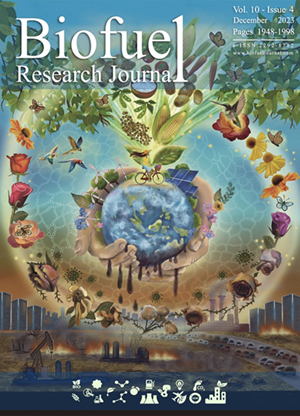A comparative evaluation of design factors on bubble column operation in photosynthetic biogas upgrading
IF 11.9
Q1 ENERGY & FUELS
引用次数: 9
Abstract
Studies attempting to optimise photosynthetic biogas upgrading by simultaneous investigation of the bubble column-photobioreactor setup have experienced considerable variability in results and conclusions. To identify the sources of such variation, this work quantitatively compared seven design factors (superficial gas velocity; liquid to gas flow rate (L/G) ratio; empty bed residence time; liquid inlet pH; liquid inlet alkalinity; temperature; and algal concentration) using the L16 Taguchi orthogonal array as a screening design of experiment. Assessments were performed using the signal to noise (S/N) ratio on the performance of CO2 removal (CO2 removal efficiency, CO2 absorption rate, and overall CO2 mass transfer coefficient) and O2 stripping (O2 concentration in biomethane and O2 flow rate in biomethane). Results showed that pH and L/G ratio were the most critical design factors. Temperature and gas residence times had minimal impact on the biomethane composition. The interactive effect between pH and L/G ratio was the most impactful, followed by the interactive effects between superficial gas velocity and L/G ratio and pH on CO2 removal efficiency. The impact of L/G ratio, algal concentration, and pH (in that order of impact) caused up to a 90% variation in oxygen content in biomethane. However, algal concentration had a diminishing role as the L/G ratio increased. Using only the statistically significant main effects and interactions, the biomethane composition (CO2% and O2%) was predicted with over 95% confidence through regression equations for superficial gas velocity up to 0.2 cm/s.光合沼气提质中气泡柱操作设计因素的比较评价
试图通过同时研究气泡柱光生物反应器装置来优化光合沼气升级的研究在结果和结论上经历了相当大的变化。为了确定这种变化的来源,本工作定量地比较了七个设计因素(表观气体速度、液气流速(L/G)比;空床停留时间;液体入口pH;液体入口碱度;温度以及藻类浓度)作为实验的筛选设计。使用信噪比对CO2去除性能(CO2去除效率、CO2吸收率和总CO2传质系数)和O2汽提性能(生物甲烷中的O2浓度和生物甲烷中O2流速)进行评估。结果表明,pH和L/G比是最关键的设计因素。温度和气体停留时间对生物甲烷组成的影响最小。pH与L/G比的交互作用对CO2去除效率的影响最大,其次是表观气体流速与L/G比对pH的交互作用。L/G比、藻类浓度和pH的影响(按影响顺序)导致生物甲烷中氧含量变化高达90%。然而,随着L/G比的增加,藻类浓度的作用逐渐减弱。仅使用统计上显著的主要影响和相互作用,通过表观气体速度高达0.2 cm/s的回归方程,预测生物甲烷组成(CO2%和O2%)的置信度超过95%。
本文章由计算机程序翻译,如有差异,请以英文原文为准。
求助全文
约1分钟内获得全文
求助全文
来源期刊

Biofuel Research Journal-BRJ
ENERGY & FUELS-
CiteScore
22.10
自引率
1.50%
发文量
15
审稿时长
8 weeks
期刊介绍:
Biofuel Research Journal (BRJ) is a leading, peer-reviewed academic journal that focuses on high-quality research in the field of biofuels, bioproducts, and biomass-derived materials and technologies. The journal's primary goal is to contribute to the advancement of knowledge and understanding in the areas of sustainable energy solutions, environmental protection, and the circular economy. BRJ accepts various types of articles, including original research papers, review papers, case studies, short communications, and hypotheses. The specific areas covered by the journal include Biofuels and Bioproducts, Biomass Valorization, Biomass-Derived Materials for Energy and Storage Systems, Techno-Economic and Environmental Assessments, Climate Change and Sustainability, and Biofuels and Bioproducts in Circular Economy, among others. BRJ actively encourages interdisciplinary collaborations among researchers, engineers, scientists, policymakers, and industry experts to facilitate the adoption of sustainable energy solutions and promote a greener future. The journal maintains rigorous standards of peer review and editorial integrity to ensure that only impactful and high-quality research is published. Currently, BRJ is indexed by several prominent databases such as Web of Science, CAS Databases, Directory of Open Access Journals, Scimago Journal Rank, Scopus, Google Scholar, Elektronische Zeitschriftenbibliothek EZB, et al.
 求助内容:
求助内容: 应助结果提醒方式:
应助结果提醒方式:


